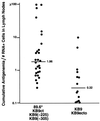Membrane-fusing capacity of the human immunodeficiency virus envelope proteins determines the efficiency of CD+ T-cell depletion in macaques infected by a simian-human immunodeficiency virus
- PMID: 11356972
- PMCID: PMC114277
- DOI: 10.1128/JVI.75.12.5646-5655.2001
Membrane-fusing capacity of the human immunodeficiency virus envelope proteins determines the efficiency of CD+ T-cell depletion in macaques infected by a simian-human immunodeficiency virus
Abstract
The mechanism of the progressive loss of CD4+ T lymphocytes, which underlies the development of AIDS in human immunodeficiency virus (HIV-1)-infected individuals, is unknown. Animal models, such as the infection of Old World monkeys by simian-human immunodeficiency virus (SHIV) chimerae, can assist studies of HIV-1 pathogenesis. Serial in vivo passage of the nonpathogenic SHIV-89.6 generated a virus, SHIV-89.6P, that causes rapid depletion of CD4+ T lymphocytes and AIDS-like illness in monkeys. SHIV-KB9, a molecularly cloned virus derived from SHIV-89.6P, also caused CD4+ T-cell decline and AIDS in inoculated monkeys. It has been demonstrated that changes in the envelope glycoproteins of SHIV-89.6 and SHIV-KB9 determine the degree of CD4+ T-cell loss that accompanies a given level of virus replication in the host animals (G. B. Karlsson et. al., J. Exp. Med. 188:1159-1171, 1998). The envelope glycoproteins of the pathogenic SHIV mediated membrane fusion more efficiently than those of the parental, nonpathogenic virus. Here we show that the minimal envelope glycoprotein region that specifies this increase in membrane-fusing capacity is sufficient to convert SHIV-89.6 into a virus that causes profound CD4+ T-lymphocyte depletion in monkeys. We also studied two single amino acid changes that decrease the membrane-fusing ability of the SHIV-KB9 envelope glycoproteins by different mechanisms. Each of these changes attenuated the CD4+ T-cell destruction that accompanied a given level of virus replication in SHIV-infected monkeys. Thus, the ability of the HIV-1 envelope glycoproteins to fuse membranes, which has been implicated in the induction of viral cytopathic effects in vitro, contributes to the capacity of the pathogenic SHIV to deplete CD4+ T lymphocytes in vivo.
Figures





Similar articles
-
Understanding the basis of CD4(+) T-cell depletion in macaques infected by a simian-human immunodeficiency virus.Vaccine. 2002 May 6;20(15):1934-7. doi: 10.1016/s0264-410x(02)00072-5. Vaccine. 2002. PMID: 11983249 Review.
-
Envelope glycoprotein determinants of increased fusogenicity in a pathogenic simian-human immunodeficiency virus (SHIV-KB9) passaged in vivo.J Virol. 2000 May;74(9):4433-40. doi: 10.1128/jvi.74.9.4433-4440.2000. J Virol. 2000. PMID: 10756060 Free PMC article.
-
Rapid CD4+ T-lymphocyte depletion in rhesus monkeys infected with a simian-human immunodeficiency virus expressing the envelope glycoproteins of a primary dual-tropic Ethiopian Clade C HIV type 1 isolate.AIDS Res Hum Retroviruses. 2004 Jan;20(1):27-40. doi: 10.1089/088922204322749477. AIDS Res Hum Retroviruses. 2004. PMID: 15000696
-
V3 loop-determined coreceptor preference dictates the dynamics of CD4+-T-cell loss in simian-human immunodeficiency virus-infected macaques.J Virol. 2005 Oct;79(19):12296-303. doi: 10.1128/JVI.79.19.12296-12303.2005. J Virol. 2005. PMID: 16160156 Free PMC article.
-
CD4-HIV-1 Envelope Interactions: Critical Insights for the Simian/HIV/Macaque Model.AIDS Res Hum Retroviruses. 2018 Sep;34(9):778-779. doi: 10.1089/AID.2018.0110. Epub 2018 Jul 9. AIDS Res Hum Retroviruses. 2018. PMID: 29886767 Free PMC article. Review.
Cited by
-
Evidence for a cytopathogenicity determinant in HIV-1 Vpr.Proc Natl Acad Sci U S A. 2002 Jul 9;99(14):9503-8. doi: 10.1073/pnas.142313699. Epub 2002 Jul 1. Proc Natl Acad Sci U S A. 2002. PMID: 12093916 Free PMC article.
-
Genetic signatures of HIV-1 envelope-mediated bystander apoptosis.J Biol Chem. 2014 Jan 31;289(5):2497-514. doi: 10.1074/jbc.M113.514018. Epub 2013 Nov 21. J Biol Chem. 2014. PMID: 24265318 Free PMC article.
-
Viral Characteristics Associated with the Clinical Nonprogressor Phenotype Are Inherited by Viruses from a Cluster of HIV-1 Elite Controllers.mBio. 2018 Apr 10;9(2):e02338-17. doi: 10.1128/mBio.02338-17. mBio. 2018. PMID: 29636433 Free PMC article.
-
HIV-1 envelope glycoproteins isolated from Viremic Non-Progressor individuals are fully functional and cytopathic.Sci Rep. 2019 Apr 3;9(1):5544. doi: 10.1038/s41598-019-42075-3. Sci Rep. 2019. PMID: 30944395 Free PMC article.
-
Single amino acid change in gp41 region of HIV-1 alters bystander apoptosis and CD4 decline in humanized mice.Virol J. 2011 Jan 21;8:34. doi: 10.1186/1743-422X-8-34. Virol J. 2011. PMID: 21255440 Free PMC article.
References
-
- Baba T, Liska V, Kimani A, Ray N, Dailey P, Penninck D, Bronson R, Greene M, McClure H, Martin L, Ruprecht R. Live attenuated, multiply deleted simian immunodeficiency virus causes AIDS in infant and adult macaques. Nat Med. 1999;5:194–203. - PubMed
-
- Barouch D H, Santra S, Schmitz J E, Kuroda J J, Fu T M, Wagner W, Bilska M, Craiu A, Zheng X X, Krivulka G R, Beaudry K, Lifton M A, Nickerson C E, Trigona W L, Punt K, Freed D C, Guan L, Dubey S, Casimiro D, Simon A, Davies M E, Chastain M, Strom T B, Gelman R S, Montefiori D C, Lewis M G, Shiver J, Letvin N. Control of viremia and prevention of clinical AIDS in rhesus monkeys by cytokine-augmented DNA vaccination. Science. 2000;290:486–492. - PubMed
-
- Barre-Sinoussi F, Chermann J C, Rey F, Nugeyre M T, Chamaret S, Gruest J, Dauguet C, Axler-Blin C, Vezinet-Brun F, Rouzioux C, Rozenbaum W, Montagnier L. Isolation of a T-lymphotropic retrovirus from a patient at risk for acquired immune deficiency syndrome (AIDS) Science. 1983;220:868–871. - PubMed
Publication types
MeSH terms
Substances
Grants and funding
LinkOut - more resources
Full Text Sources
Other Literature Sources
Research Materials

